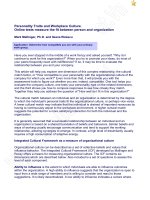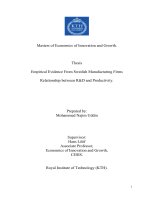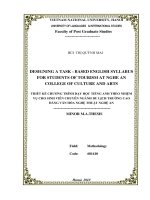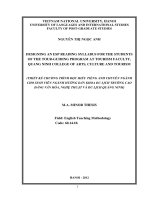Workplace culture and productivity
Bạn đang xem bản rút gọn của tài liệu. Xem và tải ngay bản đầy đủ của tài liệu tại đây (558.02 KB, 20 trang )
WORKPLACE CULTURE AND PRODUCTIVITY
By Alan Augustson
Survey and Questionnaire Design
Harris School of Public Policy Studies
The University of Chicago
ABSTRACT
This survey offers a means of defining workplace culture and
measuring its relationship to productivity. It is intended
to be used together with internal organizational
measurements of productivity, in order to facilitate change
among organizations interested in improvement.
CONTENTS
I. INTRODUCTION
II. DEFINING WORKPLACE CULTURE, AND IDENTIFYING ITS ELEMENTS
III. INTRODUCTION TO THE SURVEY
A. DESIGN AND TESTING
B. APPLICATIONS
C. ADMINISTRATION OF THE SURVEY
IV. THE SURVEY
I. INTRODUCTION
It should seem rather natural that human capital, and
its development, are areas of particular interest to me.
After all, I have labored in about two dozen workplaces in
my lifetime, nearly all of them hopelessly dysfunctional.
One cannot study the world's best business practices, all
the while subjecting himself to the world's worst, without
developing a fascination with workplace culture and its
relationship to productivity.
With both public and private entities feeling the
effects of adverse economic conditions that are likely to
last for years, employers appear on the surface to be
blessed with a buyer's market for labor. However, these
employers are themselves at the mercy of a shrinking
consumer base, one that has been complaining of poor service
for decades, and one that itself now seems to have a buyer's
market.
Corporations and bureaucracies cannot have missed this,
as many now are at least paying lip-service to a new,
customer-centered service philosophy. Indeed, an entirely
new industry called Customer Relationship Management (CRM)
has emerged, bearing tools and practices that some believe
can give flesh to that ideal.
But can a change in philosophy have any meaning outside
the boardroom? Can a firm "dumb down" its hiring standards
and shortcut its training processes, in an effort to save on
personnel costs, and then seek to provide a better consumer
experience through "smart" software and scripted procedures?
Principal-agent theory suggests that this cannot
happen, without substantial accompanying changes in the day-
to-day operating environment in the proverbial trenches.
Without adjusting the balance of positive and negative
reinforcement, the detachment between behavior and bottom
line is maintained in the mind of the employee. Given the
same system of incentives to cooperate or defect, the
employee will conserve his or her effort toward the
customer, and neither will notice any change in the overall
experience.
II. DEFINING WORKPLACE CULTURE, AND IDENTIFYING ITS ELEMENTS
For purposes of this proposal, I would like to define
"productivity" as the mean units of output per employee in a
workplace. Although output will obviously take different
forms in different environments, it may still be possible to
compare one workplace to another using this definition. Even
if this is not possible, one can still benchmark current
levels of productivity in a single workplace, and thereafter
test for improvements in a longitudinal study.
I have identified (and seek to measure and test) the
following factors that that can be described as "cultural"
in nature, and that I hypothesize will show a significant
relationship to productivity:
• Opportunity: Granted, no one moves from the mail room
to the vice president's office anymore, if indeed
people ever did. Such scenarios are more the realm of
bad fiction. But to what extent do employees feel
empowered to better their salaries, perks, and overall
positions; through their own actions and within their
current employment environment?
• Autonomy: With anarchy at one end of the continuum, and
dictatorial micromanagement at the other; to what
extent do employees feel empowered to make their own
moment-to-moment decisions and exercise their own
judgment within a given workplace?
• Security: To what extent does an employee feel
replaceable, or irreplaceable, in his or her current
job? This factor may assume any of a number of
contexts. For instance, is a job felt to be so
undesirable that no one else would want it? Or, is a
workplace so inefficient that it actually takes an
effort to get oneself fired?
• Significance: This differs from security in that it
takes into account the health and position of the
company in the mind of the employee. To what extent
does a given employee sense the direct relationship
between his or her efforts and the success of the
organization? Can a job be perceived as so
insignificant that it truly does not matter how well or
how poorly it is done?
• Polarization: Does an "us versus them" relationship
exist in the minds of employees, with respect to
management? If so, then how often (if ever) does one of
"us" get promoted to one of "them"? Are new supervisors
and managers developed internally, or are they almost
always hired in from elsewhere? Do employees, who
satisfy all current requirements, receive any training
or grooming for the next level? Are managers perceived
as competent, i.e., do they understand the processes
that they manage?
• Morale: Given that different organizations have
differing abilities to compensate, promote, etc.; to
what extent do employees feel valued for their
performance and contributions in their current roles?
Is input ever solicited from employees prior to making
a substantial change (e.g. in benefits, procedures,
etc.) that directly affects them?
• Resources: Do employees feel that they have the tools
and information needed to do their jobs and make
correct decisions? Is information consistent across
different channels? Is policy and procedure followed
and enforced evenly between different employees and
different departments? Do employees have to defer
decisions that they feel quite capable of making
themselves? Is effort wasted on redundant or
duplicative tasks, made necessary by current procedures
or policy?
These (and, I'm sure, other) factors constitute the
elements of workplace culture that I believe will show a
significant direct relationship to productivity.









